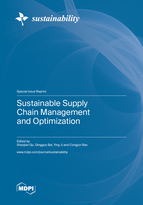Sustainable Supply Chain Management and Optimization
A special issue of Sustainability (ISSN 2071-1050). This special issue belongs to the section "Sustainable Management".
Deadline for manuscript submissions: closed (31 January 2023) | Viewed by 44310
Special Issue Editors
Interests: supply chain management; group decision-making; portfolio management; robust optimization; game theory and decision theory; methods
Special Issues, Collections and Topics in MDPI journals
Interests: sustainable supply chain operations management; operational research theory and application
Special Issues, Collections and Topics in MDPI journals
Interests: data analysis and data mining, big data technology and application, supply chain management, robust optimization, decision and game
Special Issues, Collections and Topics in MDPI journals
Interests: group decision-making; decision and game; big data technology and application; supply chain management
Special Issues, Collections and Topics in MDPI journals
Special Issue Information
Dear Colleagues,
In recent years, with the awareness of environmental protection gradually taking root, the WCED put forward the concept of sustainable development in 1987. Its main idea is development; starting with protecting the environment and ensuring the sustainability of resources, and then carrying out economic and social development. Since this concept was introduced, sustainable development has spread in many industries. In the 1990s, scholars began to study sustainable supply chain management in order to pay attention to environmental protection and contribute to social development in the process of supply chain management.
Due to the complex and changing global trade environment and the intensification of economic and trade conflicts, enterprises have become more cautious about economic development. Therefore, more and more enterprises are paying increasing attention to the construction and investment of the supply chain for sustainable development and obtaining important benefits to ensure supply, reduce costs, improve efficiency, and control risks by improving the competitiveness of the supply chain. Enterprises are also integrating sustainability into enterprise strategy and operation management; combining it with ensuring safety, quality, and internal control; exploring the innovation and reform of enterprise operation and management and the reform of industry development with supply chain innovation and reform; and building an ecosystem composed of customers, enterprises, and suppliers. At present, a safe, stable, and sustainable supply chain not only has become positioned as the core competitiveness of enterprise development but has also gradually evolved into the key to the sustainable development of the industrial chain.
The topics to be discussed will include identifying management factors for sustainable supply chain development in order to promote innovative development of sustainable supply chain systems, such as carbon footprint and emissions, waste, air pollution, big data, cost management, agricultural supply chain, and supply-chain finance.
In this Special Issue, original research articles and reviews are welcome. Research areas may include (but are not limited to) the following:
- Supply chain management based on big data;
- Research on supply chain decisions under disturbance;
- Research on the supply chain from the perspective of game theory;
- Supply chain management in uncertain environments;
- Research on supply chain development under the influence of policy;
- Research on green supply chain under low carbon economy;
- Logistics and environmental protection in the supply chain.
We look forward to receiving your contributions.
References:
- World Commission on Environment and Development (WCED), (1987). Our Common Future, Oxford: Oxford University Press.
- Dhahri, S.,& Omri, A. (2018). Entrepreneurship contribution to the three pillars of sustainable development: What does the evidence really say?, World Development, 106, 64-77.
- Soundararajan, V., & Brown, J. A. (2016). Voluntary governance mechanisms in global supply chains: Beyond CSR to a stakeholder utility perspective, Journal of Business Ethics, 134 (1), 83-102.
- Hart, S. L., & Milstein, M. B. (2003). Creating sustainable value, Academy of Management Perspectives, 17 (2), 56-67.
- Yin, J., Qian, L., & Singhapakdi, A. (2018). Sharing sustainability: How values and ethics matter in consumers’ adoption of the public bicycle-sharing scheme, Journal of Business Ethics, 149 (2), 313-32.
Prof. Dr. Shaojian Qu
Prof. Dr. Qingguo Bai
Prof. Dr. Ying Ji
Prof. Dr. Congjun Rao
Guest Editors
Manuscript Submission Information
Manuscripts should be submitted online at www.mdpi.com by registering and logging in to this website. Once you are registered, click here to go to the submission form. Manuscripts can be submitted until the deadline. All submissions that pass pre-check are peer-reviewed. Accepted papers will be published continuously in the journal (as soon as accepted) and will be listed together on the special issue website. Research articles, review articles as well as short communications are invited. For planned papers, a title and short abstract (about 100 words) can be sent to the Editorial Office for announcement on this website.
Submitted manuscripts should not have been published previously, nor be under consideration for publication elsewhere (except conference proceedings papers). All manuscripts are thoroughly refereed through a single-blind peer-review process. A guide for authors and other relevant information for submission of manuscripts is available on the Instructions for Authors page. Sustainability is an international peer-reviewed open access semimonthly journal published by MDPI.
Please visit the Instructions for Authors page before submitting a manuscript. The Article Processing Charge (APC) for publication in this open access journal is 2400 CHF (Swiss Francs). Submitted papers should be well formatted and use good English. Authors may use MDPI's English editing service prior to publication or during author revisions.
Keywords
- environmental protection
- game
- supply chain
- green development
- ecological compensation
- uncertainty
- sustainable growth









